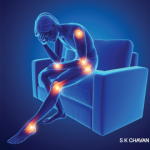One of RhoA’s functions is to allow the organization of the cytoskeleton in white blood cells in response to an infection—exactly the kind of function bacteria would want to try to wipe out, Dr. Kastner said.
Over the past year, Dr. Kastner’s lab has delved into the mechanisms by which RhoA affects the activation of the pyrin inflammasome. Bit by bit, they built a mechanistic model.
They now believe that activating RhoA activates protein kinase N1 (PKN1), which phosphorylates pyrin. That leads to the binding of the 14-3-3 protein to pyrin, which acts as a kind of molecular switch to turn off the pyrin inflammasome.
His lab has since found that RhoA is also implicated in another periodic fever syndrome—hyperimmunoglobulinemia D with periodic fever syndrome (HIDS)—except that the process in that disease seems to be brought about by a mutation in the mevalonate kinase gene, Dr. Kastner said.
‘I predict that identification of somatic mutations in known fever genes will be there in at least 5% of adults with unexplained adult-onset recurrent fevers of more than a year’s duration.’ —Dr. Kastner
Research has proceeded in a flourish, with other auto-inflammatory diseases having recently been discovered, including NLRC4-macrophage activation syndrome; DADA2, or deficiency of adenosine deaminase type 2; and a dominantly inherited form of Behçet’s disease, with onset in childhood and characterized by mutations in the TNFAIP3 gene.
The next several years will continue to yield big discoveries in the auto-inflammatory diseases, using new genetic technologies, Dr. Kastner predicted.
In the next five years, he said, exome sequencing will become “available for whoever needs it.” Also, he said, “with big data, there will be more and more opportunities for comparing the sequences of the patients we see with sequences that other people see to put two and two together.”
He also predicted that the next five years will produce at least 50 new germline auto-inflammatory loci and at least 10 new auto-inflammatory pathways.
“I predict that identification of somatic mutations in known fever genes will be there in at least 5% of adults with unexplained adult-onset recurrent fevers of more than a year’s duration,” he said. “And I believe that in the next five years, someone will come up with an effective predictive model for at least one genetically complex auto-inflammatory disease.”
Thomas R. Collins is a medical writer based in Florida.
Second Chance
If you missed this session, it’s not too late. Catch it on SessionSelect.

